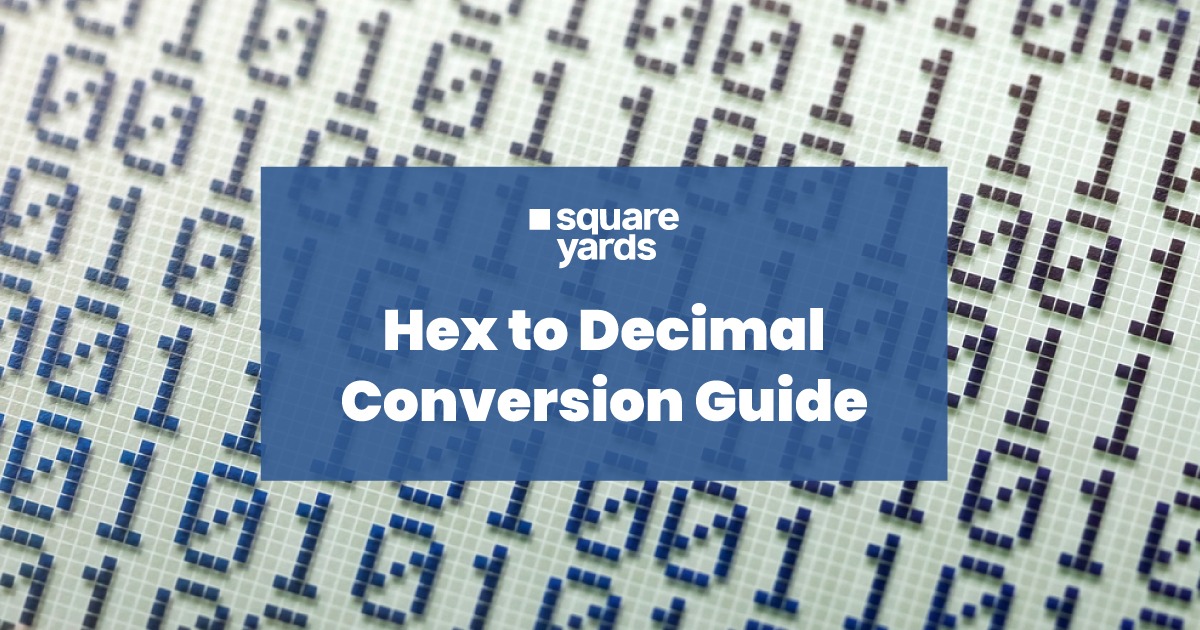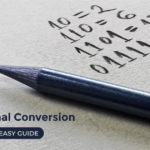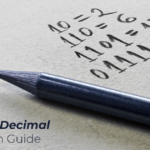Numbers are the building blocks of mathematics, and understanding different number systems is crucial for various applications. Among the diverse number systems like binary, octal, decimal, and hexadecimal (generally called Hex), we’ll focus on hexadecimal and decimal today.
In this guide, we’ll explore the fundamentals of hex and decimal number systems and discover how to convert hex to decimal manually. We will also include a conversion table and illustrative examples in this guide to further assist you in understanding the hex-to-decimal formula and conversion process.
Table of contents
What is Hex?
There’s a fascinating number system called “hexadecimal” or simply “hex”, a numerical system that works on a base value of 16. Rather than using 0 to 9 digits like the decimal system, the hexadecimal number system uses 16 symbols to depict numbers. The 16 symbols include 0, 1, 2, 3, 4, 5, 6, 7, 8, 9, A, B, C, D, E, and F. Each symbol in a hex number system holds a specific decimal value. For instance, the symbol D corresponds to the decimal value 13.
The great thing about the hex number system is that we can easily convert it into other number systems like binary with base-2, octal with base-8, and decimal with base-10. In simple words, it’s like a bridge that connects different number systems, making it easy for various applications in computing and programming.
Current Use of Hex
Hexadecimal numbers are like computing secret codes, making digital systems easier to handle. As they aid programmers in understanding what’s occurring in the computer’s memory, they are crucial in debugging and repairing faults in computer programmes. Hex is also essential for memory addressing, making it possible to access certain data places quickly. You’ll find it in MAC addresses for internet-connected devices and assembly language programming, where groups of 12 hexadecimal numbers represent different commands.
Additionally, web designers use a hex number system for colour codes like #RRGGBB, where RR stands for red, GG for green, and BB for blue, allowing them to choose precise shades and create beautiful, colourful websites.
History of Hex
The hexadecimal system dates back to the 1960s in computer science. It all started when engineers worked on the IBM System/360 and needed a way to represent binary data. The problem was that there was no standard way to represent numbers higher than nine.
In the 1950s, some places tried using the digits 0 to 5 and a special symbol (“¯”) to represent numbers from 10 to 15. But this approach didn’t sit well with the mathematical community, and it faced criticism.
Then, a mathematician at the Brookhaven National Laboratory, Bruce A. Martin, came up with a solution. He proposed a new set of symbols to offer a more logical representation of numbers beyond 9. These symbols are the familiar letters A to F used in today’s hexadecimal system.
It is now a fundamental component of computers, making it simple for us to interact with binary data and carry out different operations more clearly.
What is Decimal?
The decimal number system is one of the most commonly used ways to denote numbers. In this system, we use ten digits to represent different values – these are 0, 1, 2, 3, 4, 5, 6, 7, 8, and 9. That’s why it’s also known as the base-10 number system.
If there’s a row of boxes, and each box can hold a digit, then starting from the rightmost box, the positions of the boxes are like this: ones, tens, hundreds, thousands, and so on. Each digit’s position in the number holds a specific value based on its place in the row.
Let’s take an example to understand this better. Consider the number 568. Here, the ‘8’ is in the one’s place, the ‘6’ is in the ten’s place, and the ‘5’ is in the hundred’s place. The value of the number is calculated by multiplying each digit with its place value and summing them up:
568= (5 * 100) + (6 * 10) + (8 * 1) = 500+ 60 + 8 = 568
Current Use of Decimal
Our daily lives and many different sectors depend on decimal numbers. Decimals are used in banking and commerce to communicate money values and pricing and conduct financial transactions precisely. The decimal system is extensively used to keep track of hours, minutes, and seconds, making it simple to manage time effectively. Decimal numerals provide accurate measurements and dimensional representation in civil engineering, architecture, and construction industries.
Additionally, decimal systems are essential for database management, data analysis, and spreadsheet applications to enable trustworthy and well-organized information management.
In short, decimal numbers are the go-to choice for most human interactions and industries, simplifying our daily tasks and contributing to the accuracy of numerous applications.
History of Decimal
The base-10 number system, sometimes called the decimal number system, is lengthy and fascinating. Its origins might be traced back to ancient civilisations like Mesopotamia, and cultures like Egyptian, Greek, and Indian cultures helped to advance its development. This number system has gained much popularity since it is simple and flexible for everyday calculations.
The decimal contains 10 digits that run from 0 to 9, and it employs positional notation, in which each digit’s value is determined by its location in the number. This foundational number system is the backbone for mathematics, business, and various aspects of our daily lives, making it the most commonly used system among humans today.
Relationship Between Hex and Decimal
The relationship between hex and decimal is rooted in their distinct base values and representation of numbers. Decimal, a base-10 numbering system, employs ten digits (0-9) to represent quantities. In contrast, hexadecimal is a base-16 system, utilising sixteen digits (0-9 and A-F) to represent numbers.
The relationship becomes evident when we examine their place values. Each digit in both systems holds a specific place value, determined by its position in the number. In decimal, each digit’s place value is a power of 10 (1, 10, 100, 1000, etc.), while in hexadecimal, it is a power of 16 (1, 16, 256, 4096, etc.).
How to Convert Hex to Decimal?
Converting Hex to Decimal might seem daunting, but it’s not as tricky as it sounds. Yes, you read that right! Hex numbers can easily be converted to decimal numbers with the help of the simple steps below:
Here’s our step-by-step guide that will help you convert hex to decimal effortlessly!
Step 1: Write down the hex number you wish to convert to decimal.
Step 2: Allocate the decimal value to each hex digit by referring to the table below:
| Hex Digit | Decimal Value |
| 0 | 0 |
| 1 | 1 |
| 2 | 2 |
| 3 | 3 |
| 4 | 4 |
| 5 | 5 |
| 6 | 6 |
| 7 | 7 |
| 8 | 8 |
| 9 | 9 |
| A | 10 |
| B | 11 |
| C | 12 |
| D | 13 |
| E | 14 |
| F | 15 |
Step 3: Start from the rightmost digit and multiply each hex digit with its corresponding decimal value based on the position it occupies in the number.
Step 4: Add up all the results of Step 3 together.
Step 5: The final sum is the decimal equivalent of the hex number you wanted to convert.
That’s all! It’s this easy to convert hex to decimal without using any hex-to-decimal calculator. We provided a couple of examples in the following section of this article to assist you in understanding the conversion process better.
Formula and Examples on Hex to Decimal Conversion
The hex-to-decimal formula is:
Decimal Value = (Dn * 16^n) + (Dn-1 * 16^(n-1)) + … + (D2 * 16^2) + (D1 * 16^1) + (D0 * 16^0)
In the above formula:
- Dn, Dn-1, D2, D1, and D0 are the hexadecimal digits, where D0 is the rightmost digit, and Dn is the leftmost digit.
- ‘n’ is the position of the digit, starting from 0 for the rightmost digit and incrementing by 1 as we move to the left.
Examples of hex-to-decimal conversion are mentioned below.
Example 1: Convert the hex number 2F to decimal.
Ans. Decimal value for 2 = 2, Decimal value for F = 15.
2 (place value of 16^1) + 15 (place value of 16^0) = 32 + 15 = 47.
Example 2: Convert the hex number A7 to decimal.
Ans. Decimal value for A = 10, Decimal value for 7 = 7.
10 (place value of 16^1) + 7 (place value of 16^0) = 160 + 7 = 167.
Example 3: Convert the hex number D4 to decimal.
Ans. Decimal value for D = 13, Decimal value for 4 = 4.
13 (place value of 16^1) + 4 (place value of 16^0) = 208 + 4 = 212.
Example 4: Convert the hex number 5B to decimal.
Ans. Decimal value for 5 = 5, Decimal value for B = 11.
5 (place value of 16^1) + 11 (place value of 16^0) = 80 + 11 = 91.
Example 5: Convert the hex number EF to decimal.
Ans. Decimal value for E = 14, Decimal value for F = 15.
14 (place value of 16^1) + 15 (place value of 16^0) = 224 + 15 = 239.
Don’t miss It!
| Kilometer to Centimeter | Kilometer to Centimeter Conversion: Conversion Table, Examples |
| Centimeter to Meter | How to Convert Centimeter to Meter: Formula & Examples |
| Cubic Meter to Liter | How to Convert Cubic Meter to Liter: Formula & Examples |
| Cent to Square Feet | How to Convert Cent to Square Feet: Formula & Examples |
| Pounds to Kilogram | How to Convert Pounds to Kilogram: Formula & Examples |
| Milligrams to Grams | How to Convert Milligramsto Grams: Formula & Examples |
| Yard to Feet | How to Convert Yard to Feet Formula & Examples |
| Binary to Decimal | How to Convert Binary to Decimal: Formula & Examples |
Hex to Decimal Conversion Table
Based on the hex-to-decimal formula, we have included a hex-to-decimal conversion table below:
| Hex (Base 16) | Decimal (Base 10) |
| 0 | 0 |
| 1 | 1 |
| 2 | 2 |
| 3 | 3 |
| 4 | 4 |
| 5 | 5 |
| 6 | 6 |
| 7 | 7 |
| 8 | 8 |
| 9 | 9 |
| A | 10 |
| B | 11 |
| C | 12 |
| D | 13 |
| E | 14 |
| F | 15 |
| 10 | 16 |
| 11 | 17 |
| 12 | 18 |
| 13 | 19 |
| 14 | 20 |
| 15 | 21 |
| 16 | 22 |
| 17 | 23 |
| 18 | 24 |
| 19 | 25 |
| 1A | 26 |
| 1B | 27 |
| 1C | 28 |
| 1D | 29 |
| 1E | 30 |
| 1F | 31 |
| 20 | 32 |
| 30 | 48 |
| 40 | 64 |
| 50 | 80 |
| 60 | 96 |
| 70 | 112 |
| 80 | 128 |
| 90 | 144 |
| A0 | 160 |
| B0 | 176 |
| C0 | 192 |
| D0 | 208 |
| E0 | 224 |
| F0 | 240 |
| 100 | 256 |
| 200 | 512 |
| 300 | 768 |
| 400 | 1024 |
Difference Between Hex and Decimal
The difference between hex and decimal is tabulated below:
| Hex | Decimal |
| Hex uses 16 digits (0-9 and A-F). | Decimal uses 10 digits (0-9). |
| In hex, the place values are powers of 16 (16, 256, 4096, etc.) | In decimal, the place values are powers of 10 (10, 100, 1000, etc.). |
| Hexadecimal is commonly used in computer programming and digital electronics due to its compact representation of binary data. | Decimal is more prevalent in everyday life and standard arithmetic operations. |
| The largest single-digit number in hex is F (15 in decimal) | The largest single-digit number in decimal is 9. |
| Hexadecimal is useful for representing memory addresses and bitwise operations in programming | Decimal is used in financial calculations, measurements, and everyday arithmetic. |
Conclusion
Being able to convert from hex to decimal is helpful, especially when programming computers and using digital devicesThe step-by-step process of assigning decimal values to each hex digit and multiplying the same by corresponding powers of 16 makes the hex-to-decimal conversion easy. Understanding this straightforward yet effective conversion method will enable you to use various numbering systems and manage complicated data confidently.
FAQ’s about Hex to Decimal
Q1. How do you convert hex to decimal?
To convert hex to decimal, assign decimal values to each digit and multiply by the corresponding power of 16 based on their position.
Q2. What is the base-16 in hexadecimal?
The base-16 system in hex means that it is a numbering system that uses 16 distinct symbols to represent numbers. These symbols are the regular decimal digits 0 to 9 and the letters A to F. In a base-16 system, each digit’s place value is a power of 16, meaning the value of each digit is determined by the position it occupies within the number.
Q3. Is hexadecimal base 16 or 8?
Hexadecimal is base-16 and not base-8.




















